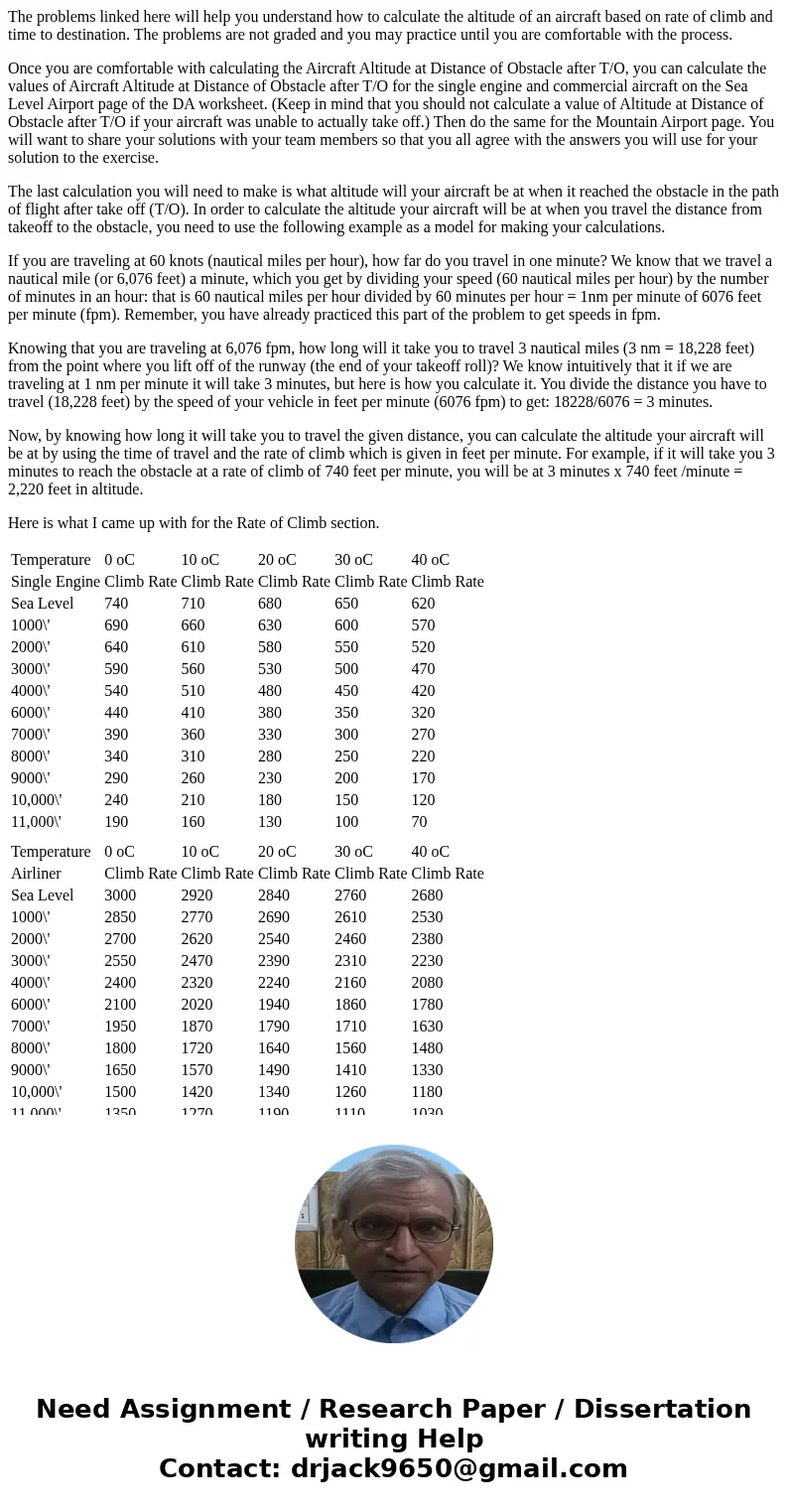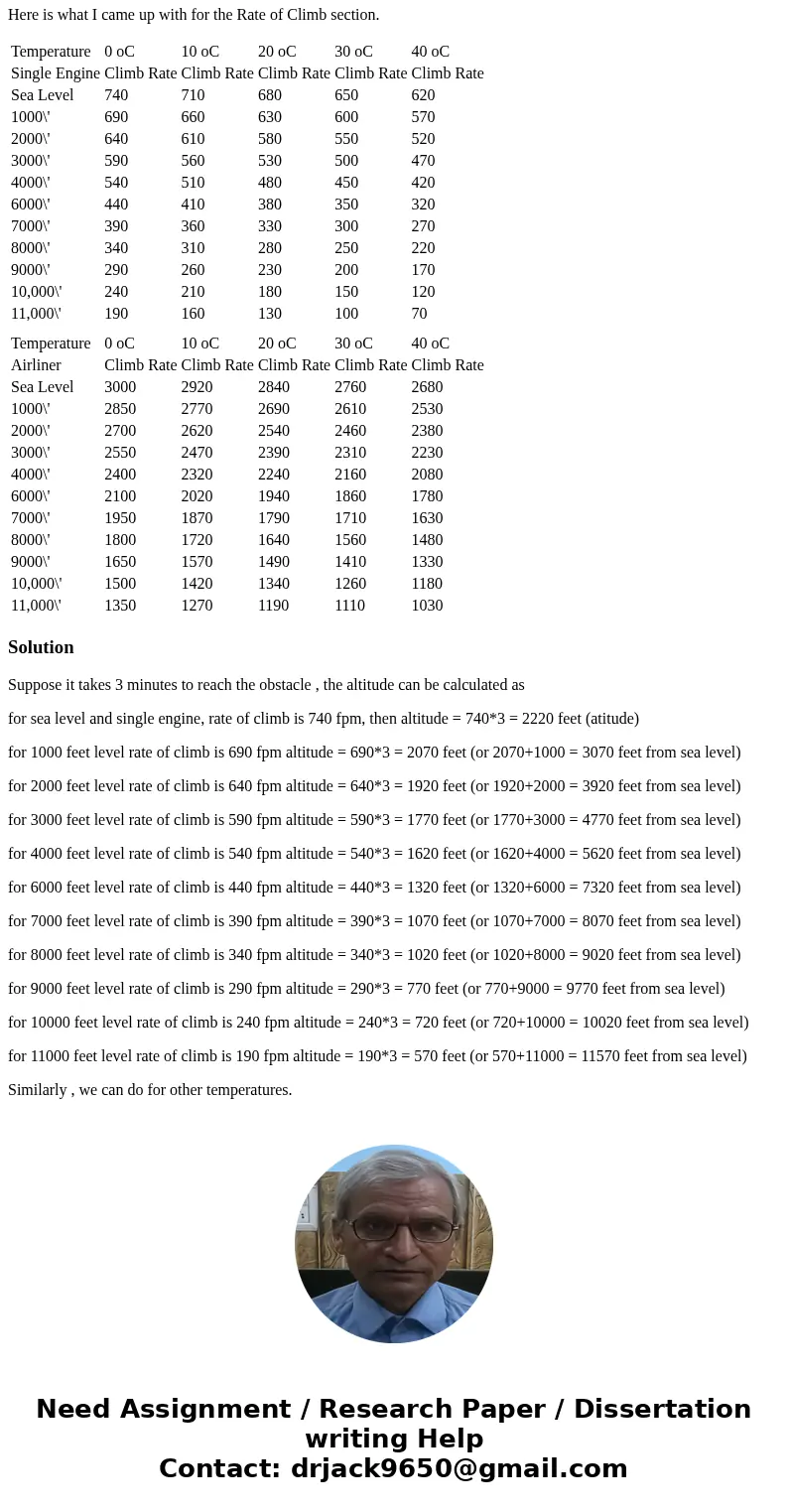The problems linked here will help you understand how to cal
The problems linked here will help you understand how to calculate the altitude of an aircraft based on rate of climb and time to destination. The problems are not graded and you may practice until you are comfortable with the process.
Once you are comfortable with calculating the Aircraft Altitude at Distance of Obstacle after T/O, you can calculate the values of Aircraft Altitude at Distance of Obstacle after T/O for the single engine and commercial aircraft on the Sea Level Airport page of the DA worksheet. (Keep in mind that you should not calculate a value of Altitude at Distance of Obstacle after T/O if your aircraft was unable to actually take off.) Then do the same for the Mountain Airport page. You will want to share your solutions with your team members so that you all agree with the answers you will use for your solution to the exercise.
The last calculation you will need to make is what altitude will your aircraft be at when it reached the obstacle in the path of flight after take off (T/O). In order to calculate the altitude your aircraft will be at when you travel the distance from takeoff to the obstacle, you need to use the following example as a model for making your calculations.
If you are traveling at 60 knots (nautical miles per hour), how far do you travel in one minute? We know that we travel a nautical mile (or 6,076 feet) a minute, which you get by dividing your speed (60 nautical miles per hour) by the number of minutes in an hour: that is 60 nautical miles per hour divided by 60 minutes per hour = 1nm per minute of 6076 feet per minute (fpm). Remember, you have already practiced this part of the problem to get speeds in fpm.
Knowing that you are traveling at 6,076 fpm, how long will it take you to travel 3 nautical miles (3 nm = 18,228 feet) from the point where you lift off of the runway (the end of your takeoff roll)? We know intuitively that it if we are traveling at 1 nm per minute it will take 3 minutes, but here is how you calculate it. You divide the distance you have to travel (18,228 feet) by the speed of your vehicle in feet per minute (6076 fpm) to get: 18228/6076 = 3 minutes.
Now, by knowing how long it will take you to travel the given distance, you can calculate the altitude your aircraft will be at by using the time of travel and the rate of climb which is given in feet per minute. For example, if it will take you 3 minutes to reach the obstacle at a rate of climb of 740 feet per minute, you will be at 3 minutes x 740 feet /minute = 2,220 feet in altitude.
Here is what I came up with for the Rate of Climb section.
| Temperature | 0 oC | 10 oC | 20 oC | 30 oC | 40 oC |
| Single Engine | Climb Rate | Climb Rate | Climb Rate | Climb Rate | Climb Rate |
| Sea Level | 740 | 710 | 680 | 650 | 620 |
| 1000\' | 690 | 660 | 630 | 600 | 570 |
| 2000\' | 640 | 610 | 580 | 550 | 520 |
| 3000\' | 590 | 560 | 530 | 500 | 470 |
| 4000\' | 540 | 510 | 480 | 450 | 420 |
| 6000\' | 440 | 410 | 380 | 350 | 320 |
| 7000\' | 390 | 360 | 330 | 300 | 270 |
| 8000\' | 340 | 310 | 280 | 250 | 220 |
| 9000\' | 290 | 260 | 230 | 200 | 170 |
| 10,000\' | 240 | 210 | 180 | 150 | 120 |
| 11,000\' | 190 | 160 | 130 | 100 | 70 |
| Temperature | 0 oC | 10 oC | 20 oC | 30 oC | 40 oC |
| Airliner | Climb Rate | Climb Rate | Climb Rate | Climb Rate | Climb Rate |
| Sea Level | 3000 | 2920 | 2840 | 2760 | 2680 |
| 1000\' | 2850 | 2770 | 2690 | 2610 | 2530 |
| 2000\' | 2700 | 2620 | 2540 | 2460 | 2380 |
| 3000\' | 2550 | 2470 | 2390 | 2310 | 2230 |
| 4000\' | 2400 | 2320 | 2240 | 2160 | 2080 |
| 6000\' | 2100 | 2020 | 1940 | 1860 | 1780 |
| 7000\' | 1950 | 1870 | 1790 | 1710 | 1630 |
| 8000\' | 1800 | 1720 | 1640 | 1560 | 1480 |
| 9000\' | 1650 | 1570 | 1490 | 1410 | 1330 |
| 10,000\' | 1500 | 1420 | 1340 | 1260 | 1180 |
| 11,000\' | 1350 | 1270 | 1190 | 1110 | 1030 |
Solution
Suppose it takes 3 minutes to reach the obstacle , the altitude can be calculated as
for sea level and single engine, rate of climb is 740 fpm, then altitude = 740*3 = 2220 feet (atitude)
for 1000 feet level rate of climb is 690 fpm altitude = 690*3 = 2070 feet (or 2070+1000 = 3070 feet from sea level)
for 2000 feet level rate of climb is 640 fpm altitude = 640*3 = 1920 feet (or 1920+2000 = 3920 feet from sea level)
for 3000 feet level rate of climb is 590 fpm altitude = 590*3 = 1770 feet (or 1770+3000 = 4770 feet from sea level)
for 4000 feet level rate of climb is 540 fpm altitude = 540*3 = 1620 feet (or 1620+4000 = 5620 feet from sea level)
for 6000 feet level rate of climb is 440 fpm altitude = 440*3 = 1320 feet (or 1320+6000 = 7320 feet from sea level)
for 7000 feet level rate of climb is 390 fpm altitude = 390*3 = 1070 feet (or 1070+7000 = 8070 feet from sea level)
for 8000 feet level rate of climb is 340 fpm altitude = 340*3 = 1020 feet (or 1020+8000 = 9020 feet from sea level)
for 9000 feet level rate of climb is 290 fpm altitude = 290*3 = 770 feet (or 770+9000 = 9770 feet from sea level)
for 10000 feet level rate of climb is 240 fpm altitude = 240*3 = 720 feet (or 720+10000 = 10020 feet from sea level)
for 11000 feet level rate of climb is 190 fpm altitude = 190*3 = 570 feet (or 570+11000 = 11570 feet from sea level)
Similarly , we can do for other temperatures.


 Homework Sourse
Homework Sourse